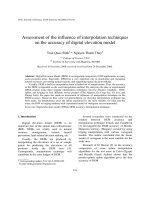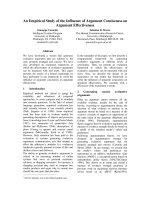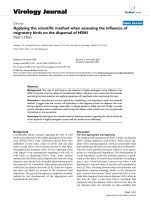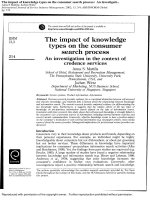The influence of knowledge sharing on motivation to transfer training a malaysian public sector context
Bạn đang xem bản rút gọn của tài liệu. Xem và tải ngay bản đầy đủ của tài liệu tại đây (2.36 MB, 365 trang )
THE INFLUENCE OF
KNOWLEDGE SHARING ON
MOTIVATION TO TRANSFER
TRAINING: A MALAYSIAN
PUBLIC SECTOR CONTEXT
A thesis submitted in fulfilment
of the requirement for the degree of
DOCTOR OF PHILOSOPHY
by
Shahril Bin Baharim
School of Management
Faculty of Business and Law
Victoria University
Melbourne, Australia
February 2008
ABSTRACT
Organisations wishing to enhance their return on investment from training must
understand the variables associated with transfer of training so that they can
promote those which enable transfer and intervene to limit those which inhibit
transfer. In the international literature on training transfer, researchers and
practitioners have acknowledged that transfer of training will occur only when
trainees have the desire or motivation to transfer training to the job.
In Malaysia, despite increasing investment in public sector training, there has
been very little research on transfer of training. This thesis contributes to a
greater understanding of transfer of training variables and how they affect
trainees’ motivation to transfer their training. Further, as the role of training has
progressively changed from a focus on programs to a broader focus on learning,
creating and sharing knowledge, this thesis tests the hypothesis that knowledge
sharing behaviour influences a trainee’s motivation to transfer their training.
Using a research framework constructed from an adaptation of two key Human
Resource Development models (Holton 1996; Holton et al. 2000) and the theory
of planned behaviour (Ajzen 1991), this thesis explores the contention that
trainees’ motivation to transfer training is influenced by a number of secondary
influence variables, expected utility variables, transfer climate variables, enabling
variables and ability variables as well as the variables associated with sharing
behaviour.
Through a questionnaire administered to 437 government employees attending
training programs in the National Institute of Public Administration, a central
training organisation for government employees in Malaysia, the thesis created an
empirical database from which to study the phenomenon of transfer of training.
This work culminated in the development of a structural model for motivation to
transfer training which incorporates knowledge sharing behaviour and extends
our understanding of the operation of the precursors to motivation to transfer.
The findings of this thesis impact on HRD functions in the Malaysian public sector
at two broad levels: pre training and post training. The thesis makes a
contribution to both HRD practice by detailing the sorts of HRD activities which
will enhance transfer of training and secondly, makes a contribution to theory
through the creation of a new model of motivation to transfer training which
features knowledge sharing behaviour.
ii
TABLE OF CONTENTS
ABSTRACT
ii
DECLARATION
xiv
PUBLICATIONS
xv
ACKNOWLEDGEMENTS
xvi
CHAPTER 1: INTRODUCTION
1.1 Background to the Research
1
1.2 Research on Training and Its Transfer in Malaysia
3
1.3 Purpose and Research Questions
5
1.4 Justification for the Research
12
1.4.1 Significance of the Thesis
12
1.5 Research Approach
13
1.6 Outline of the Thesis
13
1.7 Research Limitations and Assumptions
15
1.8 Summary
16
CHAPTER 2: TRANSFER OF TRAINING: A REVIEW
OF THE RESEARCH LITERATURE
2.1 Introduction
18
2.2 Training and Transfer of Training
19
2.3 Motivation to Transfer Training
22
2.3.1 The Kirkpatrick Model
22
2.3.2 The Learning Transfer System Inventory (LTSI)
26
iii
2.4 The Human Resource Development (HRD) Evaluation Research
and Measurement Model
31
2.4.1 Influences on Motivation to Transfer
33
2.4.2 Influences on Motivation to Learn
39
2.4.3 Influences on Learning Outcomes
42
2.4.4 Influences on Individual Performance
44
2.5 Knowledge Sharing and Its Benefits
46
2.6 The Theory of Planned Behaviour
49
2.7 Summary
51
CHAPTER 3: THE RESEARCH FRAMEWORK
AND METHODOLOGY
3.1 Introduction
53
3.2 The Conceptual Framework
53
3.2.1 The Research Questions
3.3 Methodology
58
62
3.3.1 Questionnaire Design
62
3.3.2 Sample and Data Collection
71
3.3.3 Analysis Strategy
74
3.4 Summary
90
CHAPTER 4: CONSTRUCT VALIDITY AND RELIABILITY
4.1 Introduction
92
4.2 Construct Assessment
92
4.2.1 The Learner Readiness Construct
95
4.2.2 The Performance-Self Efficacy Construct
97
iv
4.2.3 The Motivation to Transfer Construct
99
4.2.4 The Transfer Effort-Performance Expectations Construct
101
4.2.5 The Performance-Outcomes Expectations Construct
104
4.2.6 The Feedback Construct
106
4.2.7 The Peer Support Construct
109
4.2.8 The Supervisor Support Construct
111
4.2.9 The Openness to Change Construct
113
4.2.10 The Personal Outcomes-Positive Construct
115
4.2.11 The Personal Outcomes-Negative Construct
118
4.2.12 The Supervisor Sanctions Construct
120
4.2.13 The Personal Capacity for Transfer Construct
123
4.2.14 The Opportunity to Use Construct
125
4.2.15 The Content Validity Construct
127
4.2.16 The Transfer Design Construct
130
4.2.17 The Sharing Behaviour Construct
132
4.2.18 The Intention to Share Construct
134
4.2.19 The Attitude Toward Knowledge Sharing Construct
137
4.2.20 The Subjective Norm Toward Knowledge Sharing
Construct
140
4.2.21 The Perceived Behavioural Control Toward
Knowledge Sharing Construct
142
4.3 Discussion
145
4.4 Summary
148
v
CHAPTER 5: HYPOTHESIS TESTING: RESULTS AND
DISCUSSION
5.1 Introduction
150
5.2 Distribution of Respondents
150
5.2.1 Distribution of Respondents by Training Types
151
5.2.2 Distribution of Respondents by Gender
152
5.2.3 Distribution of Respondents by Age
152
5.2.4 Distribution of Respondents by Level of Education
153
5.2.5 Distribution of Respondents by Work Experience
153
5.2.6 Distribution of Respondents by Position of Employment
154
5.3 Hypothesis Testing
155
5.3.1 Hypothesis Testing for Research Question One
155
5.3.2 The Relationship Between the Transfer of Training
Variables and the Type of Training Undertaken
157
5.3.3 Hypothesis Testing for Research Question Two
165
5.3.4 The Relationship Between the Transfer of Training
Variables and Trainee Demographics
173
5.4 Discussion
176
5.5 Summary
177
CHAPTER 6: HYPOTHESIS TESTING: RESULTS AND
DISCUSSION (PART 2)
6.1 Introduction
178
6.2 Hypothesis Testing
178
6.2.1 Hypothesis Testing for Research Question Three
179
6.2.2 The Key Significant Predictors of One’s
Motivation to Transfer Training
187
6.2.3 Hypothesis Testing for Research Question Four
191
vi
6.2.4 The Relationships Between Intention to Share,
Sharing Behaviour and Motivation to Transfer
192
6.2.5 Hypothesis Testing for Research Question Five
193
6.2.6 The Significant Predictors of Intention to Share
195
6.2.7 Hypothesis Testing for Research Question Six
196
6.2.8 The Direct and Indirect Relationships Between
Sharing Behaviour and Motivation to Transfer
209
6.3 The Evolution of the Final Structural Model
213
6.4 Discussion
215
6.5 Summary
216
CHAPTER 7: IMPLICATIONS FOR HRD PRACTISE,
THEORY, RESEARCH LIMITATIONS, GENERALISABILITY
AND DIRECTIONS FOR FUTURE RESEARCH
7.1 Introduction
217
7.2 Implications for HRD Practice
217
7.2.1 The Importance of Diagnosing Transfer of Training
218
Variables
7.2.2 The Influence of Sharing Behaviour on
225
Motivation to Transfer
7.3 Implications for HRD Theory
233
7.4 Generalisability of the Study
236
7.5 Research Limitations
237
7.6 Future Research
238
7.7 Summary
240
vii
CHAPTER 8: SUMMARY AND CONCLUSIONS
8.1 Introduction
241
8.2 Summary of the Findings for HRD Practice
242
8.3 Summary of the Findings for HRD Theory
244
REFERENCES
246-262
APPENDICES
263-348
Appendix A: Main Study Questionnaire (English and Bahasa MalaysiaVersions)
Appendix B: List of Items Generated for Each Construct
Appendix C: Letter of Approval for the Pilot Study and Main Study Data
Collection
Appendix D: Letter of Approval from Ethics Committee, Victoria University
Appendix E: The Number of Distributed and Returned Questionnaire
Appendix F: The Summary of Main Study Questionnaire
Appendix H: Normal Probability Plot for the Assumption of Normality
Appendix I: Scatter Plot for the Assumption of Linearity, Homoscedasticity and
Independence of Residual
Appendix J: Item-to-Total Correlations, Inter-Item Correlations and Cronbach
Alpha for Each Construct
Appendix K: Construct Reliability and Variance Extracted Workings
Appendix L1: Multivariate Analysis of Variance Across Training Types
Appendix L2: Multivariate Analysis of Variance Across Gender
Appendix L3: Multivariate Analysis of Variance Across Age
Appendix L4: Multivariate Analysis of Variance Across Level of Education
Appendix L5: Multivariate Analysis of Variance Across Work Experience
Appendix L6: Multivariate Analysis of Variance Across Position of Employment
Appendix N: Regression Coefficient and Measurement Error Variance Workings
viii
LIST OF TABLES
Table 1.1: The Definitions of the Variables
Table 2.1: The 16 Factors of the LTSI Which Affect Transfer of Training
Table 3.1: Factors removed from the original HRD models
Table 3.2: The Statement of Hypotheses
Table 3.3: Experts Comments
Table 3.4: Results of the Item Analysis
Table 3.5: Correlation Matrix
Table 4.1: Learner Readiness Principle Component Analysis
Table 4.2: Fit Indices for Learner Readiness Construct
Table 4.3: Descriptive Statistics, Cronbach Alpha, Construct Reliability and
Variance Extracted for Learner Readiness Construct
Table 4.4: Performance-Self Efficacy Principle Component Analysis
Table 4.5: Fit Indices for Performance-Self Efficacy Conctruct
Table 4.6: Descriptive Statistics, Cronbach Alpha, Construct Reliability and
Variance Extracted for Performance-Self Efficacy Construct
Table 4.7: Motivation to Transfer Principle Component Analysis
Table 4.8: Fit Indices for Motivation to Transfer Construct
Table 4.9: Descriptive Statistics, Cronbach Alpha, Construct Reliability and
Variance Extracted for Motivation to Transfer Construct
Table 4.10: Transfer Effort-Performance Expectations Principle Component
Analysis
Table 4.11: Fit Indices for Transfer Effort-Performance Expectations Construct
Table 4.12: Descriptive Statistics, Cronbach Alpha, Construct Reliability and
Variance Extracted for Transfer Effort-Performance Expectations Construct
Table 4.13: Performance-Outcomes Expectations Principle Component Analysis
Table 4.14: Fit Indices for Performance-Outcomes Expectations Construct
Table 4.15: Descriptive Statistics, Cronbach Alpha, Construct Reliability and
Variance Extracted for Performance-Outcomes Expectations Construct
Table 4.16: Feedback Principle Component Analysis
Table 4.17: Fit Indices for Feedback Construct
Table 4.18: Descriptive Statistics, Cronbach Alpha, Construct Reliability and
Variance Extracted for Feedback Construct
Table 4.19: Peer Support Principle Component Analysis
Table 4.20: Fit Indices for Peer Support Construct
Table 4.21: Descriptive Statistics, Cronbach Alpha, Construct Reliability and
Variance Extracted for Peer Support Construct
Table 4.22: Supervisor Support Principle Component Analysis
Table 4.23: Fit Indices for Supervisor Support Construct
Table 4.24: Descriptive Statistics, Cronbach Alpha, Construct Reliability and
Variance Extracted for Supervisor Support Construct
Table 4.25: Openness to Change Principle Component Analysis
Table 4.26: Fit Indices for Openness to Change Construct
ix
Table 4.27: Descriptive Statistics, Cronbach Alpha, Construct Reliability and
Variance Extracted for Openness to Change Construct
Table 4.28: Personal Outcomes-Positive Principle Component Analysis
Table 4.29: Fit Indices for Personal Outcomes-Positive Construct
Table 4.30: Descriptive Statistics, Cronbach Alpha, Construct Reliability and
Variance Extracted for Personal Outcomes-Positive Construct
Table 4.31: Personal Outcomes-Negative Principle Component Analysis
Table 4.32: Fit Indices for Personal Outcomes-Negative Construct
Table 4.33: Descriptive Statistics, Cronbach Alpha, Construct Reliability and
Variance Extracted for Personal Outcomes-Negative Construct
Table 4.34: Supervisor Sanctions Principle Component Analysis
Table 4.35: Fit Indices for Supervisor Sanctions Construct
Table 4.36: Descriptive Statistics, Cronbach Alpha, Construct Reliability and
Variance Extracted for Supervisor Sanctions Construct
Table 4.37: Personal Capacity for Transfer Principle Component Analysis
Table 4.38: Fit Indices for Personal Capacity for Transfer Construct
Table 4.39: Descriptive Statistics, Cronbach Alpha, Construct Reliability and
Variance Extracted for Personal Capacity for Transfer Construct
Table 4.40: Opportunity to Use Principle Component Analysis
Table 4.41: Fit Indices for Opportunity to Use Construct
Table 4.42: Descriptive Statistics, Cronbach Alpha, Construct Reliability and
Variance Extracted for Opportunity to Use Construct
Table 4.43: Content Validity Principle Component Analysis
Table 4.44: Fit Indices for Content Validity Construct
Table 4.45: Descriptive Statistics, Cronbach Alpha, Construct Reliability and
Variance Extracted for Content Validity Construct
Table 4.46: Transfer Design Principle Component Analysis
Table 4.47: Fit Indices for Transfer Design Construct
Table 4.48: Descriptive Statistics, Cronbach Alpha, Construct Reliability and
Variance Extracted for Transfer Design Construct
Table 4.49: Sharing Behaviour Principle Component Analysis
Table 4.50: Fit Indices for Sharing Behaviour Construct
Table 4.51: Descriptive Statistics, Cronbach Alpha, Construct Reliability and
Variance Extracted for Sharing Behaviour Construct
Table 4.52: Intention to Share Principle Component Analysis
Table 4.53: Fit Indices for Intention to Share Construct
Table 4.54: Descriptive Statistics, Cronbach Alpha, Construct Reliability and
Variance Extracted for Intention to Share Construct
Table 4.55: Attitude Toward Knowledge Sharing Principle Component Analysis
Table 4.56: Fit Indices for Attitude Toward Knowledge Sharing Construct
Table 4.57: Descriptive Statistics, Cronbach Alpha, Construct Reliability and
Variance Extracted for Attitude Toward Knowledge Sharing Construct
Table 4.58: Subjective Norm Toward Knowledge Sharing Principle Component
Analysis
Table 4.59: Fit Indices for Subjective Norm Toward Knowledge Sharing
Construct
Table 4.60: Descriptive Statistics, Cronbach Alpha, Construct Reliability and
Variance Extracted for Subjective Norm Toward Knowledge Sharing Construct
Table 4.61: Perceived Behavioural Control Principle Component Analysis
x
Table 4.62: Fit Indices for Perceived Behavioural Control Construct
Table 4.63: Descriptive Statistics, Cronbach Alpha, Construct Reliability and
Variance Extracted for Perceived Behavioural Control Construct
Table 5.1: Distribution of Respondents by Training Types
Table 5.2: Distribution of Respondents by Gender
Table 5.3: Distribution of Respondents by Age
Table 5.4: Distribution of Respondents by Level of Education
Table 5.5: Distribution of Respondents by Work Experience
Table 5.6: Distribution of Respondents by Position of Employment
Table 5.7: The Variables That Differed Across Gender, Age, Level of Education,
Work Experience and Position of Employment
Table 6.1: Model Summary
Table 6.2: ANOVA
Table 6.3: Coefficients-Secondary Influence Variables
Table 6.4: Model Summary
Table 6.5: ANOVA
Table 6.6: Coefficients-Expected Utility Variables
Table 6.7: Model Summary
Table 6.8: ANOVA
Table 6.9: Coefficients-Transfer Climate Variables
Table 6.10: Model Summary
Table 6.11: ANOVA
Table 6.12: Coefficients-Enabling Variables
Table 6.13: Model Summary
Table 6.14: ANOVA
Table 6.15: Coefficients-Ability Variables
Table 6.16: Summary of Results for Research Question Three
Table 6.17: Model Summary
Table 6.18: ANOVA
Table 6.19: Coefficients-Antecedents of Intention to Share
Table 6.20: Fit Indices for the Hypothesised Structural Model
Table 6.21: Results of the Hypothesised Structural Model
Table 6.22: Fit Indices for the Re-Specified Model 1
Table 6.23: Results of the Relationships for Re-Specified Model 1
Table 6.24: Fit Indices for the Final Structural Model
Table 6.25: Results of the Relationships for the Final Structural Model
Table 7.1: Pre-training and Post-Training Variables for HRD Functions
xi
LIST OF FIGURES
Figure 1.1: The Conceptual Framework
Figure 2.1: The Kirkpatrick Four Level Evaluation Model
Figure 2.2: The LTSI Conceptual Evaluation Model
Figure 2.3: The Learning Transfer System Inventory (LTSI)
Figure 2.4: The HRD Evaluation Research and Measurement Model
Figure 2.5: Evolution’s of Training Role
Figure 2.6: The Theory of Planned Behaviour
Figure 3.1: The Conceptual Framework
Figure 3.2: The Framework for Developing Questionnaire
Figure 3.3: Simplified Structural Model
Figure 4.1: Measurement Model-Learner Readiness Construct
Figure 4.2: Measurement Model-Performance-Self Efficacy Construct
Figure 4.3: Measurement Model-Motivation to Transfer Construct
Figure 4.4: Measurement Model-Transfer Effort- Performance Expectations
Construct
Figure 4.5: Measurement Model-Performance-Outcomes Expectations Construct
Figure 4.6: Measurement Model-Feedback Construct
Figure 4.7: Measurement Model-Peer Support Construct
Figure 4.8: Measurement Model-Supervisor Support Construct
Figure 4.9: Measurement Model-Openness to Change Construct
Figure 4.10: Measurement Model-Personal Outcomes-Positive Construct
Figure 4.11: Measurement Model-Personal Outcomes-Negative Construct
Figure 4.12: Measurement Model-Supervisor Sanctions Construct
Figure 4.13: Measurement Model-Personal Capacity for Transfer Construct
Figure 4.14: Measurement Model-Opportunity to Use Construct
Figure 4.15: Measurement Model-Content Validity Construct
Figure 4.16: Measurement Model-Transfer Design Construct
Figure 4.17: Measurement Model-Sharing Behaviour Construct
Figure 4.18: Measurement Model-Intention to Share Construct
Figure 4.19: Measurement Model-Attitude Toward Knowledge Sharing Construct
Figure 4.20: Measurement Model-Subjective Norm Toward Knowledge Sharing
Construct
Figure 4.21: Measurement Model-Perceived Behavioural Control Toward
Knowledge Sharing Construct
Figure 6.1: Hypothesised Structural Model
Figure 6.2: The Results for the Hypothesised Structural Model
Figure 6.3: The Results for the Re-Specified Model 1
Figure 6.4: The Results for the Final Structural Model
xii
xiii
DECLARATION
“I, SHAHRIL BIN BAHARIM, declare that the PhD thesis entitled ‘The
Influence of Knowledge Sharing on Motivation to Transfer Training. A
Malaysian Public Sector Context’, is no more than 100,000 words in length,
exclusive of tables, figures, appendices and references. This thesis contains no
material that has been submitted previously, in whole or in part, for the award of
any other academic degree or diploma. Except where otherwise indicated, this
thesis is my own work”.
Signature: ________________________ Date: _______________
xiv
PUBLICATIONS
The following are a list of publications derived from this research.
Baharim, S & Van Gramberg, B 2005, ‘The influence of knowledge sharing on
transfer of training: a proposed research strategy’, in: Proceedings of the
Association of Industrial Relations Academic of Australia and New
Zealand Conference, 9-11 February 2005, Sydney, Australia.
Baharim, S & Van Gramberg, B 2006, ‘The influence of knowledge sharing on
transfer of training: a proposed research strategy’, The ICFAI Journal of
Knowledge Management, vol.4, no.1, pp. 47-58.
Baharim, S & Van Gramberg, B 2007, ‘The relationship between knowledge
sharing and transfer of training: a conceptual model’, in Lahiri, K (eds.),
ICFAI University Press.
Baharim, S & Van Gramberg, B 2007, ‘Factors affecting motivation to transfer. A
Malaysian Public Sector Study’, School of Management, Victoria
University Working Paper.
xv
ACKNOWLEDGEMENTS
At last…I have made it! What an amazing learning journey it has been.
First, I would like to thank to my wonderful family, especially to my loving wife
Surina who had sacrificed her time and career accompanying me in Melbourne to
undertake my PhD. Her encouragement and never ending flow of moral support
had given me back the confidence I so badly needed but had lost. Also to all my
children Aliya, Adam, Sarah and Alif….they are all under 10 years of age, they
haven’t got any idea what this task is all about but never doubted their dad will
succeed. My profound thank to my parents, brothers and sisters for their never
ending encouragement.
Second, I would like to express my sincere appreciation to my supervisor
Associate Professor Dr Bernadine Van Gramberg who took me on as her student.
Her guidance, assistance, patience and support over the long years of research
work are very invaluable especially during the frustrating times. I found that such
supervision has significantly contributed to this research. My appreciation also
goes to Richard Gough for his assistance and suggestions in statistics. I would also
like to thank to Associate Professor Patrick Foley for his generous time with
AMOS and structural equation modeling. I will never forget the hospitality he and
his wife have shown me.
Third, I would be remiss if I did not address the following individuals who helped
me during the pilot and main study data collection. They are: Saadiah Yaakob
(Accountant General’s Department), Amiruddin Muhammed (Ministry of Finance)
and Abdul Latif Ahmad (Accountant General’s Department).
Forth, I am deeply indebted to Y. Bhg. Datuk Siti Maslamah Osman (Accountant
General 2000-2003), who gave me her support for a study leave. I owe her a
special debt of gratitude. A special thanks to the present Accountant General Dato’
Mohd Salleh Mahmud who inspired and supported me to come to study in
Australia. My special thanks also goes to Tn Hj. Ab. Gani Haron (Deputy
Accountant General-Operation), Teh Ben Chu (Director EGAG) and Tn Hj.
Mohsin Hussein (Director BPAS). My sincere apologies to others whose names I
have not mentioned.
Finally, my profound thanks to all my PhD Colleagues, especially to Tafir and his
wife for providing my wife and my children with temporary stay during the last
phase of my PhD. We will never forget the kindness he and her wife had shown to
us.
xvi
For my wife
Surina
and my children
Aliya, Adam, Sarah and Alif
xvii
CHAPTER 1
INTRODUCTION
1.1 Background to the Research
The government of Malaysia has a vision for the country to become a fully developed
nation by the year 2020 (Mohamed 2003). In order to achieve this, Malaysia requires
a knowledgeable and skilful workforce to compete successfully in meeting the
challenges ahead. In this regard, developing human capital is a top priority of the
Malaysian government (Hashim 2001). This is evidenced by a recent government
announcement of an allocation of RM 33.4 billion in the 2007 national budget to
further strengthen the education and training system (Ahmad Badawi 2006).
The public sector plays a vital role as an enabler and facilitator of private sector
initiatives by providing efficient delivery systems and a customer-focused service.
These roles lie with the approximately 1.3 million government employees working in
the public sector in positions from clerical to top executives (Public Service
Department of Malaysia 2006). In order to ensure that these employees are equipped
with the necessary knowledge and skills, the Malaysian government has given
particular attention to workplace training as a tool for improving employees’ job
performance. This has included programs such as management training (for example,
human resource management; strategic management; financial management),
computer training (for example, visual basic; database management) and general
training (for example, writing skills; better spoken English) (National Institute of
Public Administration Malaysia 2005).
Key to the success of training program initiatives is the extent to which trainees use
their training on the job. Over the years, researchers and practitioners have
acknowledged that transfer of training must occur before learning can lead to an
improvement in an individual’s job performance (Holton 1996; Holton, Bates &
1
Ruona 2000). This, in turn, represents the essence of return on investment (ROI) of
training. Transfer of training has been defined as the degree to which trainees apply
the knowledge and skills gained in training to their job (Ford & Weissbein 1997;
Tannenbaum & Yulk 1992; Wexley & Latham 1991). The acquisition of knowledge
and skills gained in training is of little value if the new characteristics are not taken
back to the job setting or are not maintained over time (Bates 2003; Kozlowski &
Salas 1997). Surprisingly, it has been reported that a mere 10 percent of the
investment in training is returned in performance improvement (Garavaglia 1993).
Despite the reported problems in training transfer in the research literature, workplace
training is still viewed as a primary strategy by organisations to gain a competitive
advantage. This is because the goal of training is for employees to master the
knowledge and skills learned, and this in turn, is argued as being critical for
successful job performance (Goldstein 1992; Noe 2005; Wexley & Latham 1991).
It has been noted that transfer of training will occur when trainees have the desire or
motivation to use the knowledge and skills learned in their training (Baldwin & Ford
1988; Noe 1986; Noe & Schmitt 1986; Wexley & Latham 1991). However, little is
known about factors that could affect trainees’ motivation to transfer training to the
job (Seyler, Holton, Bates, Burnett & Carvalho 1998; Tannenbaum & Yulk 1992).
Clearly, a better understanding the factors that enhance trainees’ use of their learned
skills and knowledge on the job would be valuable in determining how to motivate
trainees to use the knowledge and skills so that the organisation is benefited.
In the light of the importance of investment in training as a strategy for the Malaysian
government (and indeed for many organisations), this thesis aims to identify the key
contributing factors to transfer of training. This Chapter presents an overview of the
thesis, commencing with a discussion of the contention that transfer of training and in
particular, one’s motivation to transfer one’s learning, are key components to
productive training program design and implementation and represent factors which
will contribute to ROI of training costs. The Chapter then moves to describe the
2
research questions driving the thesis and outlines briefly, the methodology and
limitations of the research.
1.2 Research on Training and its Transfer in
Malaysia
Despite a small body of literature on employee training in Malaysia, there has been
very little research on transfer of training. Of the variety of studies covering different
aspects of training, one observes a general agreement that a lack of understanding of
training needs assessment and training evaluation inhibits human resource
development (HRD) initiatives in that country. The widespread absence of these
practices may have contributed to a belief that ROI on training investment is itself,
illusive. For example, Zakaria and Rozhan (1993) examined the HRD practices in the
manufacturing sector in Malaysia and found that despite 44 percent of surveyed firms
conducting formal training, a lack of expertise amongst training managers meant that
23 percent of them did not first conduct a training needs assessment. In another study
of 54 Malaysian manufacturing firms and 46 service sector firms, Poon and Othman
(2000) found that although the organisations developed basic processes such as
training needs assessment and training evaluation, implementation of these processes
was poorly handled. Further, training needs assessment was found to be based on past
data such as job content or company records to identify training needs (rather than
current audits of skills gaps, for instance). Likewise, training evaluation relied on
rating sheets handed out at the end of training programs to trainees and were thus
highly subjective and one dimensional.
A study by Saiyadain (1995) examining attitudes towards training found that
sponsoring managers (i.e., those managers directly concerned with the training
activities) from smaller sized companies had relatively more negative perceptions to
training than those in larger organisations. Further, training in those smaller
organisations was given low priority because of the managers’ inability to see
tangible benefits of training. This was confirmed by Hashim (2001) who found that
3
training evaluation was overwhelmingly reliant on reactive measures such as trainee
feedback and observation rather than on other ROI measures. A related study by
Saiyadain and Ali (1995) found that measurement of training effectiveness was
inconsistent in Malaysian firms and that most Malaysian managers did not have
formal education in management, a fact which itself, impacted negatively on their
training and development efforts.
Only in one study (Hameed & Analoui 1999), was the problem of transfer in
management training and development examined and this was situated in the
manufacturing sector. The study revealed that among the inhibiting transfer factors in
the workplace (to transfer of training occurring) were the different perceptions and
understanding between staff and management; the presence of a conflicting
environment (training and workplace); a lack of recognition; and constraints relating
to company’s policies and procedures.
Although the studies described above have contributed greatly to the collective
knowledge in managerial training in a Malaysian setting, they represent a very small
body of research which has had little impact on HRD practice. This was confirmed by
the survey of the literature on training and development of managers in Malaysia by
Saiyadain and Ali (1995) who indicated that there was a dearth of published
empirical material on managerial training. Since then, the study by Hashim (2001)
marks the only recent contribution to the field.
HRD researchers have acknowledged that the role of training has changed from a
program focus to a broader focus on learning and creating and sharing knowledge
(Martocchio & Baldwin 1997; Noe 2005; Noe, Hollenbeck, Gerhart & Wright 2004).
Employees are expected to acquire new skills and knowledge, apply them on the job
and share this information with fellow workers (Noe 2005). However, in the context
of the Malaysian public sector, research investigating how knowledge sharing could
play its role in transfer of training has been neglected. This thesis, therefore, sets
itself squarely in the research gap with the aim of contributing to the HRD discipline
4
in Malaysia through a comprehensive study of factors which promote transfer of
training in the Malaysian public sector.
1.3 Purpose and Research Questions
Research suggests that transfer factors vary across organisations, training types and
trainees’ demographics and they vary between being strong and weak with respect to
their effect on transfer itself (Chen 2003; Donovan, Hannigan & Crowe 2001; Holton,
Chen & Naquin 2003; Yamnill 2001). This means that organisations wishing to
enhance ROI from training must understand all the transfer factors and intervene to
remove factors that inhibit transfer. Key to this discussion is that researchers and
practitioners have acknowledged that transfer of training will occur only when
trainees have the desire or motivation to transfer their training on the job (Baldwin &
Ford 1988; Noe 1986; Noe & Schmitt 1986; Wexley & Latham 1991). It follows that
organisations would be well advised to identify the factors that enhance trainees’
motivation to transfer their training particularly as the goal of most training is for
trainees to master the knowledge and skills required to perform well in their daily job
(Noe 2005).
This thesis contributes to a greater understanding of the nature of the motivational
factors which underpin trainees’ desire to transfer what they have learned into their
everyday jobs. The thesis also tests the hypothesis that knowledge sharing behaviour
also influences a trainee’s motivation to transfer their training. Preliminary evidence
on the concept of knowledge sharing behaviour (Noe et al. 2004) demonstrates that it
plays some role in transfer of training by acting through trainee motivational factors.
Two key models were used to explore the areas of motivation and knowledge sharing.
First, using the Human Resource Development Evaluation Research and
Measurement Model (the HRD model) developed by Holton (1996), this thesis
focuses on the contribution to trainee motivation of 16 variables identified Holton’s
model as:
5
1. secondary influence variables (performance-self efficacy and learner
readiness);
2. expected utility variables (transfer effort-performance expectations and
performance-outcomes expectations);
3. transfer climate variables (feedback, peer support, supervisor support,
openness to change, personal outcomes-positive, personal outcomes-negative
and supervisor sanctions);
4. ability variables (personal capacity for transfer and opportunity to use); and
5. enabling variables (content validity and transfer design)
The second model used in this thesis is the Theory of Planned Behaviour (TPB)
model devised by Ajen (1991) (see Chapter 3) from which the knowledge sharing
behaviour variables were tested. Thus, the conceptual framework for this thesis
amends the model by Holton (1996) by incorporating the sharing behaviour elements
(sharing behaviour, intention to share, attitude toward knowledge sharing, subjective
norms toward knowledge sharing, perceived behavioural control toward knowledge
sharing) to provide a more expanded view of the transfer of training framework. It
should be noted that Holton did not consider knowledge sharing in his HRD model.
The development of the research questions for this study arose in response to the
paucity of research investigating the question of how transfer of training variables
and the variables associated with sharing behaviour perform in the Malaysian public
sector. Research questions one and two explore the similarities and differences of
transfer of training and sharing behaviour across three training types (general
training; management/leadership training; computer training) and demographics
(gender; age; level of education; work experience; position of employment)
respectively. These two research questions are important because it gives important
information on which transfer of training variables are strong, weak or moderate.
Having the knowledge on which transfer variables were strong, moderate or poor
may assists the researcher to proceed with further analysis to identify which among
the strong variables are significant in explaining the variation in motivation to
6
transfer training. This thesis anticipates that there is no significant difference in these
variables across training types and demographics and that the variables can be
generalised. This issue is taken up in Chapter 3.
Research question three was devised to explore which variables explain the variation
in motivation to transfer and thus provides information allowing the development of
recommendations to HRD managers on how to improve trainees’ motivation to
transfer their training. Research questions four to six were devised to explore the
possible linkages between sharing behaviour and motivation to transfer, to explore
trainees’ intention to share and to explore the direct and indirect relationships (via the
significant predictors identified in research question three) between sharing
behaviour and motivation to transfer. The six research questions are listed below:
Research Question One:
Which of these transfer of training variables:
•
motivation to transfer;
•
secondary influences (performance-self efficacy, learner readiness);
•
expected utility (transfer effort-performance expectations, performanceoutcomes expectations);
•
transfer climate (feedback, peer support, supervisor support, openness to
change, personal outcomes-positive, personal outcomes-negative, supervisor
sanctions);
•
ability (personal capacity for transfer, opportunity to use);
•
enabling (content validity, transfer design); and
•
TPB (sharing behaviour, intention to share, attitude toward knowledge
sharing, subjective norms toward knowledge sharing, perceived behavioural
control toward knowledge sharing) are significantly different in terms of their
mean
score
across
different
training
types
(general
training,
management/leadership training, computer training)?
7
Research Question Two:
Which of these transfer of training variables:
•
motivation to transfer;
•
secondary influences (performance-self efficacy, learner readiness);
•
expected utility (transfer effort-performance expectations, performanceoutcomes expectations);
•
transfer climate (feedback, peer support, supervisor support, openness to
change, personal outcomes-positive, personal outcomes-negative, supervisor
sanctions);
•
ability (personal capacity for transfer, opportunity to use),
•
enabling (content validity, transfer design); and
•
TPB (sharing behaviour, intention to share, attitude toward knowledge
sharing, subjective norms toward knowledge sharing, perceived behavioural
control toward knowledge sharing) are significantly different in terms of their
mean score across trainees’ demographics (gender, age, level of education,
work experience, position of employment)?
Research Question Three:
Which of these transfer of training variables:
•
secondary influences (performance-self efficacy, learner readiness);
•
expected utility (transfer effort-performance expectations, performanceoutcomes expectations);
•
transfer climate (feedback, peer support, supervisor support, openness to
change, personal outcomes-positive, personal outcomes-negative, supervisor
sanctions);
•
ability (personal capacity for transfer, opportunity to use); and
•
enabling (content validity, transfer design) serve as key significant predictors
of one’s motivation to transfer training?
8









